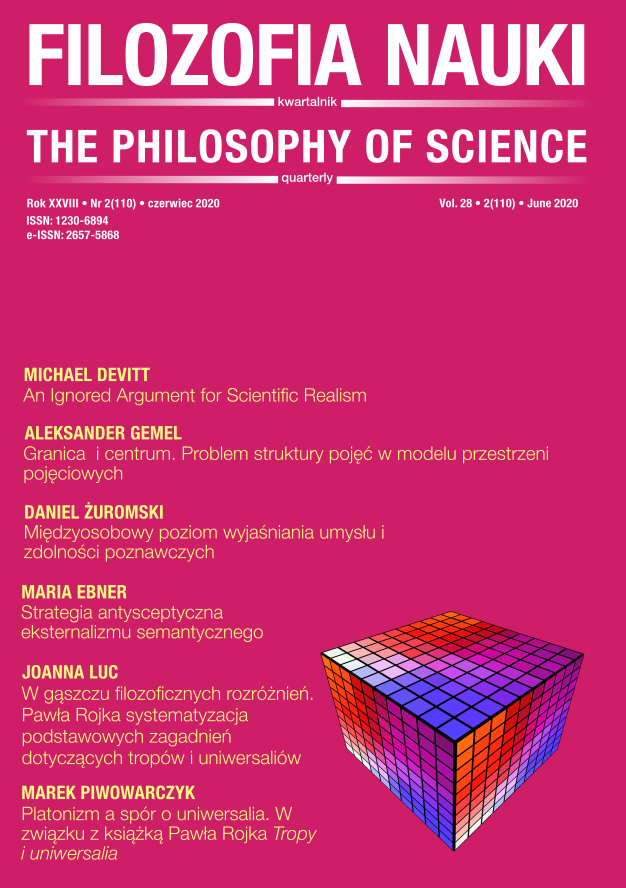Borderline and Center: The Problem of Concepts Structure in the Conceptual Spaces Framework
DOI:
https://doi.org/10.14394/filnau.2020.0008Keywords:
conceptual spaces, similarity, membership, typicality, vaguenessAbstract
One of the main aims of Peter Gärdenfors’ theory of conceptual spaces is to provide, by means of the geometric methods of representation, a formal model for the prototype structure of concepts. However, his model is not free of theoretical problems regarding an adequate description of the psychologically correct structure of concepts. Therefore, the main purpose of this paper is to raise several questions concerning the relationship between the typicality function and the membership function, as well as to propose some solutions to these problems by offering a model that binds both functions formally. Thus, the proposed model is intended to complement Gärdenfors’ conceptual spaces theory, in which the proper shape of both functions has not been sufficiently problematized. The second aim of the paper is to propose a new approach to vagueness, which is coherent with the formal requirements of the conceptual spaces framework, and at the same time is in line with the solution proposed in the first part of the text.
References
Berlin B., Kay P. (1969), Basic Color Terms, Berkeley: University of California Press.
Breysse O., De Glas M. A. (2007), New Approach to the Concepts of Boundary and Contact. Toward an Alternative to Mereotopology, „Fundamenta Informaticae” 78(2), 217-238.
Cantlon J. F., Platt M. L., Brannon E. M. (2009), Beyond the Number Domain, „Trends in Cognitive Sciences” 13(2), 83-91. https://doi.org/10.1016/j.tics.2008.11.007
Douven I., Decock L., Dietz R., Égré P. (2013), Vagueness. A Conceptual Spaces Approach, „Journal of Philosophical Logic” 42(1), 137-160. https://doi.org/10.1007/s10992-011-9216-0
Gallistel C. R., Gelman R. (2000), Non-verbal Numerical Cognition. From Reals to Integers, „Trends in Cognitive Sciences” 4(2), 59-65. https://doi.org/10.1016/S1364-6613(99)01424-2
Gärdenfors P. (2000), Conceptual Spaces. On the Geometry of Thought, Cambridge: MIT Press. https://doi.org/10.7551/mitpress/2076.001.0001
Gärdenfors P. (2014), Geometry of Meaning. Semantics Based on Conceptual Spaces, Cambridge: MIT Press. https://doi.org/10.7551/mitpress/9629.001.0001
Gärdenfors P., Williams M. A. (2001), Reasoning about Categories in Conceptual Spaces [w:] Proceedings of the 17th International Joint Conference on Artificial Intelligence, IJCAI’01, vol. 1, B. Nebel (ed.), San Francisco: Morgan Kaufmann, 385-392.
Geeraerts D. (1985), Paradigm and Paradox. Explorations into a Paradigmatic Theory of Meaning and its Epistemological Background, Leuven: Leuven University Press.
Geeraerts D. (1989), Introduction. Prospects and Problems of Prototype Theory, „Linguistics” 27, 587-612. https://doi.org/10.1515/ling.1989.27.4.587
Gemel A. (2016), Problem geometrycznej reprezentacji podobieństwa w koncepcji przestrzeni pojęciowych Petera Gärdenforsa, „Filozofia Nauki” 24(3) [95], 25-41.
Gemel A., Quinon P. (2019), Magnitude and Number Sensitivity of the Approximate Number System in Conceptual Spaces [w:] Conceptual Spaces. Elaborations and Applications, M. Kaipainen, F. Zenker, A. Hautamäki, P. Gärdenfors (eds.), Cham: Springer, 183-203. https://doi.org/10.1007/978-3-030-12800-5_10
Jäger G. (2010), Natural Color Categories Are Convex Sets [w:] Logic, Language, and Meaning, M. Aloni, H. Bastiaanse, T. de Jager, K. Schulz (eds.), Berlin: Springer, 11-20. https://doi.org/10.1007/978-3-642-14287-1_2
Keefe R., Smith P. (1997), Introduction. Theories of Vagueness [w:] Vagueness. A Reader, R. Keefe, P. Smith (eds.), Cambridge: MIT Press, 1-57.
Kleiber G. (2003), Semantyka prototypu, kategorie i znaczenie leksykalne, tłum. B. Ligara, Kraków: Universitas.
Kubiński T. (1958), Nazwy nieostre, „Studia Logica” VII, 115-179. https://doi.org/10.1007/BF02548937
Lakoff G. (2011), Kobiety, ogień i rzeczy niebezpieczne. Co kategorie mówią nam o umyśle, tłum. M. Buchta, A. Kotarba, A. Skucińska, Kraków: Universitas.
Lee I., Portier B. (2007), An Empirical Study of Knowledge Representation and Learning within Conceptual Spaces for Intelligent Agents [w:] 6th IEEE/ACIS International Conference on Computer and Information Science, R. Lee, M. U. Chowdhury, S. Ray, T. Lee (eds.), Los Alamitos: IEEE Computer Society, 463-468. https://doi.org/10.1109/ICIS.2007.57
McGee V., McLaughlin B. (1994), Distinctions without a Difference, „Southern Journal of Philosophy” 33(S1), 203-251. https://doi.org/10.1111/j.2041-6962.1995.tb00771.x
Minda J. P., Smith J. D. (2002), Comparing Prototype-Based and Exemplar-Based Accounts of Category Learning and Attentional Allocation, „Journal of Experimental Psychology. Learning, Memory, and Cognition” 28(2), 275-292. https://doi.org/10.1037/0278-7393. 28.2.275
Okabe A., Boots B., Sugihara K. (1992), Spatial Tessellations. Concepts and Applications of Voronoi Diagrams, New York: John Wiley & Sons.
Osherson D. N., Smith E. E. (1981), On the Adequacy of Prototype Theory as a Theory of Concepts, „Cognition” 9(1), 35-58.
Rosch E. (1975), Cognitive Representation of Semantic Categories, „Journal of Experimental Psychology” 104(3), 192-233. https://doi.org/10.1037/0096-3445.104.3.192
Rosch E., (1978), Principles of Categorization [w:] Cognition and Categorization, E. Rosch, B. B. Lloyd (eds.), Oxford: Lawrence Erlbaum, 27-48.
Ross B. H., Makin V. S. (1999), Prototype versus Exemplar Models in Cognition [w:] The Nature of Cognition, R. J. Sternberg (eds.), Cambridge: MIT Press, 205-241.
Sainsbury M. (1991), Is There Higher-Order Vagueness?, „Philosophical Quarterly” 41(163), 167-182. https://doi.org/10.2307/2219591
Shapiro S. (2006), Vagueness in Context, Oxford: Oxford University Press. https://doi.org/10.1093/acprof:oso/9780199280391.001.0001
Sorensen R. (2018), Vagueness [in:] The Stanford Encyclopedia of Philosophy (Summer 2018 Edition), E. N. Zalta (ed.). https://stanford.io/3e47wF6.
Storms G., De Boeck P., Ruts W. (2000), Prototype and Exemplar-Based Information in Natural Language Categories, „Journal of Memory and Language” 42(1), 51-73. https://doi.org/10.1006/jmla.1999.2669
Tversky A. (1977), Features of Similarity, „Psychological Reviews” 84(4), 327-352. https://doi.org/10.1037/0033-295X.84.4.327
Verheyen S., Égré P. (2018), Typicality and Graded Membership in Dimensional Adjectives, „Cognitive Science” 42(7), 2250-2286. https://doi.org/10.1111/cogs.12649
Zadeh L. (1978), Fuzzy Sets as a Basis for a Theory of Possibility, „Fuzzy Sets and Systems” 1, 3-28. https://doi.org/10.1016/0165-0114(78)90029-5



















 Filozofia Nauki/The Philosophy of Science | ISSN 1230-6894 | e-ISSN 2657-5868
Filozofia Nauki/The Philosophy of Science | ISSN 1230-6894 | e-ISSN 2657-5868